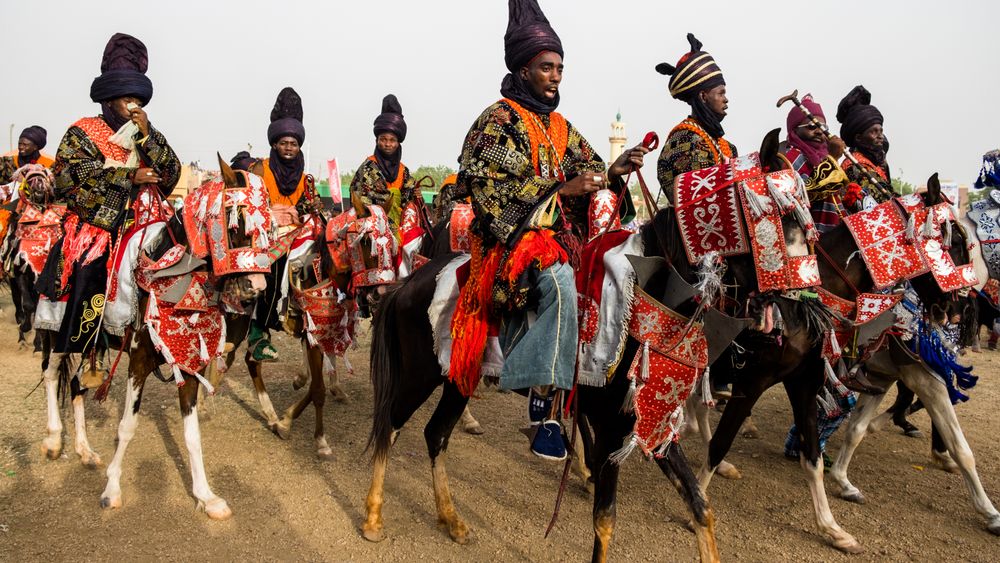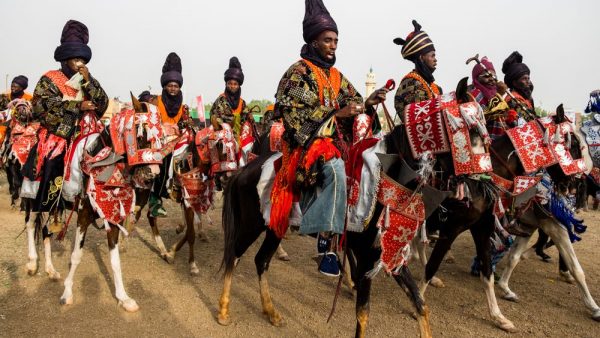One of the most popular festivals in Nigeria is the Durbar festival. This religious and equestrian event is a colourful display of culture and a true spectacle of traditional music, fashion, pomp and pageantry.
Read more about Travel and Tourism
The Durbar comes up at Eid el-Fitri, the end of one month of Islamic fasting called Ramadan. As of today, we are currently in the Ramadan season. It is also shared with Eid-el Kabir, the pilgrimage to Mecca. The Eid el-Fitri and Eid al-Adha Muslim holidays are 70 or 71 days apart.
The Durbar festival is usually celebrated by predominantly Muslim states in Nigeria like Kano, Kaduna, Kwara, Sokoto, and Niger. But the best cities to witness it are Kano, Bida (Niger state), Katsina, Zaria and Zazzau (Kaduna state), and Bauchi.
The festival is a ceremonial parade filled with nobles/chiefs, a group of equestrians, aesthetics, colours, musicians, stunts men, theatrical performances, etc. It attracts visitors and tourists year after year.
If you would like to witness the Durbar in person, here are a few things you can expect:
- Prayers – The festival starts with the Eid prayers. Sometimes, the prayers are followed by the singing of the national anthem outside town or in front of the government house. Once the anthem is on, everyone goes completely still.
- The Gunshots – A gunshot from a musket signals the beginning of the processions and the arrival of the Emir to the parade. The gunshot is sometimes accompanied by other gun salutes, other times it is followed by music.
- The Procession – The parade begins with noble families begin the procession. First, there are musicians, acrobats, dancers and guards who start the procession for each noble family. Colourfully adorned horses and their vibrantly dressed riders grace the parade grounds. Some of the riders have large turbans, glistening metallic sword, skin purses, and wear handwoven robes.
- Musicians – During the procession, there are traditional dancers, traditional drummers, trumpeters and fluters. The intense drumming, dancing and displays excite the crowd and get their approval.
- The Emir’s Procession – This part of the parade begins with members of the Emir’s household. From his horses to his servants, family members and then the emir himself. The King’s guards are adorned with ostrich feathers and coloured turbans. They carry a large parasol to cover the emir. Sometimes the Emir comes out on a horse, other times, it is a carriage pulled by horses. When the emir comes out, it is amidst gun salutes from flintlock muskets. He pays his respects to the governor who is seated in the Palace viewing area.
- The Jahi Race – This comes up after the Emir’s parade. Warriors gallop on horses as a sign of their courage, agility and respect. They brandish their swords, charge at full speed and stop in front of the emir.
Sign up to the Connect Nigeria daily newsletter
Worthy of note: The processions are strictly men only. Most people watch the Durbar from a viewing centre within the Emir’s palace that overlooks the grounds. The turbans with bunny-like ‘ears’ indicate the royal heritage of the wearer.
- Other entertainment – Also during the procession, you can expect to see acrobats flipping around, jesters making comedy skits, stick fights, knife plays, fire stunts, traditional display and more.
- Food vendors – Don’t worry about getting hungry because there will be lots of food vendors in the area.
- A Crowd – There is usually a large crowd of spectators cheering from the sides. We are not referring to tourists only but the townspeople. It is a community celebrated event so expect community members to be in attendance equally dressed to the teeth.
What you can do as a tourist
Dress up – You can dress up in the Hausa regalia to look the part.
Get Henna – You can get Henna (body art) done on your hands or feet.
Ride a Horse – You can politely ask a rider to allow you to climb their horse for a picture or horseback riding experience.
Food Tour – You can go on a food tour with the vendors at the parade grounds.
Listen & Learn – Go with a friend or a guide who is familiar with the sequence of events so you can get a first-hand understanding of what is happening per time.
Take Pictures – Feel free to make videos and snap pictures of the event. It is usually allowed on such a day.
Once the emir gives his speech after this display, the durbar is officially over. The crowds take over the parade grounds and other activities continue.
Sources:
Pulse ng
Guardian Ng
Nomad4now
Nigeria Galleria
Bookings Nigeria
Featured Image Source: Lens Culture
Got something you want to read about on our platform? Contact us: [email protected]


